
First and Only Weekly Online Fanzine Devoted to the Life and Works of Edgar Rice Burroughs Since 1996 ~ Over 15,000 Webpages and Webzines in Archive |

First and Only Weekly Online Fanzine Devoted to the Life and Works of Edgar Rice Burroughs Since 1996 ~ Over 15,000 Webpages and Webzines in Archive |


Contents
![]()
A PICTORIAL
HISTORY OF SCIENCE FICTION
ERB: THE FATHER OF SCIENTIFICTION
by David Kyle
Hamlyn Publishing Group Limited ~ London ~ 1976
There are two futures, the future of desire and the
future of fate, and man's reason has never learnt to separate them.
J. D. Bernal ~ London 1929
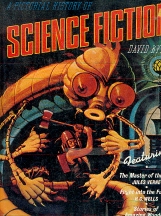
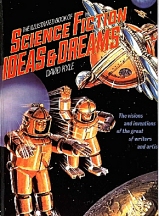
Page 44: In 1912 the most influential writer of pulp adventures appeared suddenly witlh his first two novels. Tarzan of the Apes had appeared and Edgar Rice Burroughs swung with him high above the world to fame and fortune. In a short fifteen years the pulps had found their place in Western culture; they had developed all types of fiction and generated all types of magazines...
Page 49: The big event which took place within the pages of The All-Story magazine of February 1912 was, of course, the first part, of six parts, of an exciting Martian adventure story by a new author, "Normal Bean," which was printed in error as "Norman Bean." It was the first John Carter story, Under the Moons of Mars, and it was an instantaneous success. Neither that punning pen-name nor any other nom-de-plume would ever be used again by the remarkable author, Edgar Rice Burroughs. Burroughs had called his science fantasy Dejah Thoris, Princess of Mars, but The All-Story editor, Thomas Newell Metcalf, retitled it. In the autumn of the same year of 1912, lightning struck twice in the same place. Tarzan of the Apes appeared.The character of Tarzan is difficult to define in terms of science fiction. In the early days of the popularization of science fiction, for example during the 1930s, there was no genuine sf hero. Part of the reason was the scarcity of good heroic characters with which one could identify, another part was that many of the plots in the Tarzan novels had sf-like ingredients, such as Tarzan and the Ant Men or -- and the Lost Empire or -- and the City of Gold or -- at the Earth's Core, but probably the best reason of all is that Burroughs had the sense of wonder every good sf story has.
There can be no dout abouit the dozen Martian novels which eventually were written: they are science fiction adventures -- somtimes described as science fantasies to indicate that the science in them should not be taken too seriously. At the time John Carter first set foot on Mars, however, the Martian environment was not as ridiculous as it now seems. Professor Lowell's theories of life on Mars had made just as big an impression on others as it had on the young Hugo Gernsback, and readers could accept the alien world as having more truth in it than fiction. Even the latest Mariner fly-bys of NASA keep the Red Planet still intriguingly enigmatic. The Carter of Mars setting is much as one would deduce from Lowell: a beautiful, red wasteland criss-crossed by fertile canal zones and home for older and more advanced civilizations. Of course the Virginian, Carter, finds an anachronistic world with futuristic science and medieval society blended into a thoroughly dangerous, exciting, exotic arena for adventure. Without the slightest doubt, Burroughs didn't really give a tinker's-dam about science fiction; action was his meat and drink -- he cared so little for logic that he simply had John Carter, trapped in a cave by some bloodthirsty Apaches, project himself to Mars.
To critic Sam J. Lundwall, Burroughs is an anathema; he says Burroughs wrote splendid entertainment, with breathtaking pace and skilful writing, far from great literature but full of suspense; however, considering the blood spilt, "he never should have seen print at all and his books should be banned in every library ever frequented by people under the age of fifteen years -- as for Good and Evil, they are very easily discernible: everyone intellectual or not broad-shouldered enough is a baddie, same for those with physical deformities". That is strong condemnation.
On the other hand, Donald A. Wollheim thinks differently. He says, "It was his talent in producing wonderful adventure, of building good against evil that prevails. He was not a very grand philosopher. He did not venture into deep science or propose grandiose schemes for social development. He sought to entertain and in so doing created marvels that caught the mind of the world and still do. It counts. It's old-fashioned these days but it couitns. It cannot be subtracted from the reasons why Burroughs sells today as well as he ever did. Tarzan is good, always good. His foes may be mixed, but his main foes are evil, plain downright evil. We don't get much of that in mainstream fiction these days. Too bad. When I hear that millions of young people are reading Burroughs and enjoying him, I rejoice. It may not be brilliant science fiction, but there is a light of hope here that outshines all the sour statistics of youth gone wrong."
Brian Aldiss says, "Wells is teaching us to think. Burroughs and his lesser imitators are teaching us not to think. Of course, Burroughs is teaching us to wonder. The sense of wonder is in essence a religious state, blanketing out criticism. Wells was always a critic, even in his most romantic and wondrous tales. And there, I believe, the two poles of modern fantasy stand defined. At one pole stand Wells and his honourable predecessors such as Swift; at the other, Burroughs and his imitators, such as Otis Adelbert Kline, and the weirdies, horror merchants, and the Never-Never-Landers, such as H.P. Lovecraft, and so all the way to Tolkien. Mary Shelley stands somewhere at the equator of this metaphor."
As Roger Lancelyn Green asserts, "To the schoolboy in his early teens, Burroughs can open magic casements with the best.... Those who read him at the right age owe a great debt of gratitude to Edgar Rice Burroughs." For the young at heart the right age, of course, is any age.
Burroughs not only had his imitators, such as Ralph Milne Farley and Kline, but he had his predecessors, too, whom he eclipsed. H. Rider Haggard, who was a far better writer, was dull and long-winded in comparison. Burroughs had somehow absorbed the heart and soul of the pulps. Blue Book magazine, which strove to be the most dignified of all the pulp magazines by well-designed format and choice of material, serialized the majority of Burroughs' novels. Other important pulps at the time, besides Argosy, The All-Story and Cavalier, were Short Stories, Adventure, Popular and Top Notch.
Frank Munsey's pulp magazines had greatly changed the direction of science fiction publishing. Whereas in the Victorian Age and before, the book had been the showcase for the best of the "new" ficiton, now it was the magazine. The book, as always, was the ultimate goal of the writer, his recognition within the world of letters, but the magaizne chronologically came first. These new writers with their new ideas were tested there, and the best material would live on between hard covers for a smaller, more particular and more critical audience. Science Fiction was in the process of accelerating growth. More new ideas and more variations of old ideas were multiplying and being published. But as much as the field had expanded, it was still a smaller part of the whole. For every word of fantasy of sorts, in a year of pulp publishing, there were a score of words which were not. The path to general popularity for fantasy and sicence fiction -- except for special cases such as Burroughs -- was still to be a long, hard climb -- and fantasy was the Goliath to science fiction's David. The critics, however, were still book oriented, just as the critics are today. The authors who were considered for their ideas by the literati had to be in books, perhaps sometimes in certain select quality magazines -- that is, if the idea of a scientific romance didn't already alienate any chance of being considered. More and more the pulp magazines were the natural habitat for the writers with something different to say. Fortunately, then as now, most good material eventually got decent evaluation in hardcover.
About this time of Gernsback's Ralph and Burroughs' Tarzan and Carter, George Allan England had received high praise in 1911 for his novel, The Elixir of Hate, about a man growing younger to turn into a child. as Burroughs' first novel appeared, England's best work was finishing in Cavalier magazine as a four-part serial entitled Darkness and Dawn. It was dystopian, about a savage, ruined world with sub-human people.
Page 80: Fully developed science fiction, with space-ships and rocket pistols, entered with Buck Rogers. The story, Armageddon, 2419 A.D., first appeared in the August 1928 Amazing Stories, the same issue as Doc Smith's debut with The Skylark of Space. Philip Francis Nowlan was the author. A sequel, The Airlords of Han, followed in the March 1929 Amazing. The inspiration for the cartoon creation came from the head of a national newspaper syndicate, John F. Dille, who was looking for a likely sf subject as early as 1926-27 and found it as a reader of Amazing. Dille convinced Nowlan to do the scripts for a staff artist, Dick Calkins. An authority on comics, Maurice Horn, says, "The action of the strip seems today quite a bit passe and its drawings crude, but this was the comic srip's first foray into science fiction and Buck Rogers enjoyed lasting prestige as well as immediate success." Most incredibly, another comic strip event took place that very same day, 7 January 1929, "far more revolutionary in its impact," says Horn, "ushering in the era of the modern (or 'straight') comic strip." The strip was Edgar Rice Burroughs' Tarzan and the artist, Hal Foster, was an extraordinary craftsman who later began his own origina series, Prince Valiant. The year 1929 indeed marked "a turning point in the history of the adventure strip and of the comic strip generally."
Page 107: [The success of Amazing} led in 1939 to a companion magazine, Fantastic Adventures. Within a few years these two magazines would be the most popular on the market, regularly featuring Edgar Rice Burroughs, whose last work, "The Skeleton Men of Jupiter," a novelette, was published in the February 1943 Amazing. Burroughs, as productive as ever when Palmer wanted him to build circulation, contributed seven novelettes and one novel between 1941 and 1943 for Amazing, plus five novelettes to the new Fantastic Adventures, the first as early as 1939. Neither magazine, however, ever used the mock-Burroughs, Otis Adelbert Kline, although he had appeared in both the Gernsback and SloaneAmazings.
The rivalry between Burroughs and his most blatant imitator, Kline, makes a fascinating aside. Even their names had the same ring to them and their initials were used as a shorthand identification for each: ERB and OAK. Klilne's first novel, serialized in Argosy in 1929, became a book in 1930, The Planet of Peril, a Burroughs-type story set on the planet Venus. Its success brought a sequel, The Prince of Peril, in 1930. Kline's books began to appear in hard-covers by the same publishers doing Burroughs'; in an unlikely coincidence, Burroughs started his own publising company and kept his books separate from Kline's. In 1931 OAK did an imitation-Tarzan which Weird Tales published in 1931, Tam, Son of the Tiger, possibly saving that magazine from failure. OAK followed with another imitation, Jan of the Jungle, in the 1931 Argosy. ERB retaliated with Pirates of Venus, winding up Carson Napier and setting him loose right on Kline's planet. Argosy, forced by subject matter to make a choice, rejected OAK's Buccaneers of Venus to publish ERB's first Venusian story and OAK ended up in Weird Tales. It was OAK's turn; he jumpted to ERB's territory with The Swordsman of Mars which Argosy featured. The two authors continued to write about the planets they had swapped. By 1935 ERB had reasserted his supremacy.
Page 140: Devotees of Edgar Rice Burroughs are the most active, specialized group in sf fandom, apart from those from Star Trek who developed independent of the general science fiction field. The Burroughs Bibliophiles meet annually, and individual amateur publications, such as ERB-dom, The Barsoomian, The Gridley Wave, etc., are published for a limited following.
SCIENCE FICTION: AN ILLUSTRATED HISTORY
by Sam J. Lundwall
Grosset & Dunlap ~ New York ~ 1977Page 48: ... an important part of the true space opera, that of the abducted princesses, empires to be won and dynasties to be founded, came to a large degree from the Edgar Rice Burroughs space adventures starting with Thuvia, Maid of Mars (1916).
Page 113: Science fiction in the United States faithfully followed the pulp magazine formula, as witness the greatest names of the time -- Edgar Rice Burroughs, E. E. Smith, Edmond Hamilton and others. The magazines were edited by people who migh have loved science fiction but also had to bow to publishers who wanted nothing but fast profits. Monsters and wild adventures always sold, and with one editor forced to edit perhaps two or three or four magazines simultaneously, no one can wonder that the results were often disastrous.
SCIENCE FICTION: THE ILLUSTRATED ENCYCLOPEDIA
by John Clute
1995 MacMillan Canada: TorontoEdgar Rice Burroughs
1875-1950
AmericanPage 118: Key Works: The Barsoom Series, the Pellucidar Series, The Land that Time Forgot
It is embarrassing for many SF lovers to admit that, when they really want to enjoy themselves with a book, their hand will stray to the shelf where the tales of Edgar Rice Burroughs live.They may reach for a story of Tarzan, a Barsoom epic, or The Land That Time Forgot; the effect will almost always be the same. Time and again, the works of Burroughs cast us back into the bright, haunted childhood of our reading, where his heroes' every exploit is clad in dreamlike certainty.
Certainly Burroughs can be mocked. His style - especially in his early, best novels -- is florid, and often inexact to a ludicrous degree. His Africa never existed, and the populous, canal-rich Mars of his Planetary Romances was known to be scientifically outrageous long before he stopped telling stories of John Carter, thews tautened by Earth gravity, and of his Princess, breasts bared to the mild Mars air.
There may be no real secret behind Burroughs's huge success -- or a very simple one: the heroes are wish fulfillments. But Burroughs does not stint himself or cheat us. As long as the book lasts, the wish comes true.
Page 213: A Princess of Mars
All-Story pulp magazine 1912 by "Norman Bean" ~ Hard cover 1917 by ERB (A.C. McClurg Publishers)
Before Burroughs, other planets were almost always visited for purposes of education: writers created otherworldly societies to show readers by contrast what was wrong, or right, with the human world. But Burroughs's Mars is all escapist fun: a hero, a naked princess, swords, sorceries, battles, and wonders.
Page 95: Edgar Rice Burroughs, the next writer (after H.G. Wells) to use Mars extensively in his work, never cared (if there Mars actually could support real life). It was enough for him, and for dozens of other writers, that Mars could plausibly be imagined to contain life, and he transported his hero John Carter there with the greatest of aplomb to dominate the Martians. This is what Earthmen did so well, in so many tales, partly just because they were human, and partly because Mars (being smaller) has a lower gravity than Earth and so would have weaker inhabitants. Burroughs never worried about whether or not the Mars of his dreams -- a paradise straight out of Arabian Nights, full of naked but safely nonhuman) women -- could ever possibly exist, in either past or present.
HELL'S CARTOGRAPHERS
Some Personal Histories of Science Fiction Writers
Edited by Brian W. Aldiss and Harry Harrison
Harper & Row, Publishers ~ New York ~ Copyright 1975 by SF Horizons, Ltd.
Brian Aldiss: Magic and Bare Boards
pp 194 & 195We can identify two streams in science fiction, two streams which have now (though uneasily) become one: what I call the 'once-for-once-only' stream and the pulp stream.The 'once-for-once-only' stream is a direct literary response to a new factor or a change in society, generally brought about by a technological development, as are most societal changes. The first good example is Mary Shelley's Frankenstein (so much better a book than all the horror movies allow), provoked by new sciences, new discoveries (the opening up of the South Seas for instance), and new philosophies, such as the evolutionary speculations of Erasmus Darwin. The line of inheritance then goes on through -- shall we say -- Verne, de l'Isle Adam, Butler, Bellamy, Wells, Kafka, Huxley, Skinner, Orwell, et al. The books of these men are once-for-once-only responses to or examinations of some new aspect of the world.
The other stream is the pulp stream. When Gernsback started his magazines in the late twenties, he invented sf as a genre, a category. No chance of the 'once-for-once-only' approach here! By their very nature, the pulps appeared regularly, with a regular amount of space to fill. So modern sf was established, wherein a lot of underpaid authors rather frantically cribbed or sparked ideas off each other -- at its rare best, the process did become some sort of a meaningful dialogue....
The pulp stream also witnessed the triumph of the editor over the writer....
But the great distinction to be made between the two streams in their heyday is that whereas the 'once-for-once-only' stream was, by its nature, a critical literature, even in the case of its most noted practitioner, H. G. Wells, the pulp stream quickly turned to power-fantasy and escapism. Here, the great practitioner is Edgar Rice Burroughs, one of the best-selling, if not the most best-sellingest, sf writers of all time. Burroughs' influence has been pervasive and often detrimental; among Tarzan's descendants is certainly Heinlein's Michael Valentine Smith of Stranger in a Strange Land.
Submitted by Frank Blisard
Frederik Pohl: Ragged Claws
pp 145 & 147-152... 1930. The world was numb under the great depression. I remember the cold city streets, gloveless relief workers shoveling snow outside the second-hand magazine store where I browsed through the old copies of Amazing Stories before selecting the one in which I would invest my dime. I remember a hot summer in my uncle's attic, smelling of salt and curing tobacco, where I found a treasure trove, twenty years back years of Argosy and Weird Tales. I opened the pages of an Amazing Stories Annual and Mars smote me, four-armed green warriors riding six-legged steeds across the ochre plains of the evaporated seas.No one could have suggested to me then that Edgar Rice Burroughs did not far outshine Sir Walter Scott... One might have pointed out that my judgement could have been flawed because I had not read Scott...
No matter, I imprinted when it was imprinting time. A year or two later I discovered I was not alone in the world, when I joined a magazine's circulation-promotion scheme called The Science Fiction League...
. . .
[SF writers] were opening up a new vantage point from which to observe the human race: that dislocation in space, or in time, which permits what Harlow Shapley calls 'the view from a distant star'. How enlightening that view is! How much more clearly we can see the folly and arbitrariness and transience of our own ways when we look at them from Barsoom or from the end of time.So that was there, in those ragged pulp magazines of four or five decades ago: social satire. It made a whole generation of us both cynics and dreamers: cynic, because at the same time other writers were offering us Utopias and magnificent challenges.
The greatest challenge of all, of course, was space. Barsoom. Osnome. Persephone, and the planets of Arcturus and Altair. Where the fantasy life of the normal pre-pubescent male involved strutting into a Texas town, throwing a silver dollar on the bar and shooting it out with a sheriff, ours involved chopping squat, evil Fenachrone into hamburger with shimmering spheres of force. Where the normal fantasy life of the post-pubescent male involved girls, ours also involved girls -- but pink-skinned, oviparous little angels like Dejah Thoris, or the doomed, possessed princesses who haunted the waterside bars of ancient Venus in the stories of Northwest Smith.
And all this was going on, remember,, in a world that was gradually putting itself together after the cataclysm of the 1929 crash, en route to the catastrophe of World War II. Out of work veterans were being burned out of their shacks on Anacostia Flats because they were demanding a bonus and the government could find no money to give them. Hungry men sold apples in the streets. Not everyone was broke and despairing in those times, but everyone had seen what happened to a brother or a friend, and everyone was afraid. So we suffered from culture shock. Not from encountering Martians or Plutonians, but from looking up from th he pages of Science Wonder Stories or Amazing and seeing the insanity outside our windows that we were told was 'real'.
As quickly as we could, we fled back to Barsoom.
Need I make a parenthesis to explain the meaning of the word 'Barsoom'? Probably not; Edgar Rice Burroughs's invented Mars still lives on; just the other day I saw the covers for a whole new reprinting of the saga, nearly a dozen books, going out in hundreds of thousands to an audience that must still somehow find them as enchanting as we did forty years ago. John Carter was the founder of the house. A veteran of the Civil War (on the rebel side) he happened to find himself trapped in a western cave with a horde of howling Apaches just outside, urging him to come out so they could torture him to death. If Zane Grey had been writing the story, Carter would have come out in a burst of unexpected action, seized the chief, stolen a horse and made his escape. Burroughs got his man out of that spot in a more inventive way, if not a perceptibly more believable one: Carter steals out when the Apaches aren't looking, gazes upward longingly at the planet Mars, holds out his hands to it... and somehow, Burroughs did not feel obliged to explain exactly how, is drawn to it, and awakens to find himself on Mars itself, with a four-armed green warrior holding a sword to his throat.
Well, so much for that: the rest of the story is swordplay and rescued princesses. I honestly would not care to relate the plot of any of the Mars books to even the friendliest of audiences.
But plot is only a detail. There is more to the Mars books than that. I do not speak of literary style -- Burroughs was a pulpster, hitting his typewriter keyboard with clenched fists. I speak of morality, and perception, and thought. Burroughs used Mars to comment on Earth, just as Swift used Lilliput and Laputa. In The Master Mind of Mars he ridiculed religion, an act not without courage. In all the books he jabbed at prudery (the Barsoomians ornamented their bodies instead of concealing them). The 'stately formal dances' of the Barsoomian nobles no doubt reflect his displeasure with the Charleston and the Bunny Hug. And so on; I will not labour the point, but if the man was writing adventure it was not just adventure.
It was even scientifically accurate. That, I admit, is a claim for Burroughs not often heard, but I think it is defensible. True, Burroughs's Barsoom is not much like the Mars of the Mariner photographs. But is is very like the Mars of Percival Lowell, and that was all that science knew of Mars at the time. Low gravity: Carter leaps over a Barsoomian building with a single bound. (I write it that way because it is how Burroughs wrote it; but how I wonder, do you leap over anything with a double bound?) Thin air: Burroughs fixes that, by building great 'atmosphere factories' which constantly replenish the molecules that dance out into space. It is even possible to suppose that, in some way, he has anticipated the 'atmosphere factories' that a scientist like Krafft Ehricke would now build on the Moon if he could, because the Barsoomian factories use as raw material what Burroughs calls the 'eighth ray', while Ehricke would use what current science calls the 'solar wind', also a flux of charged particles. We cannot fault Burroughs for his ignorance without faulting all of fin de siecle astronomy. When he wrote A Princess of Mars the question of Mars's habitability was about an even bet. Lowell put his money on the side of Martian life; in fact, he and others were less interested in the question of whether life did exist on Mars, than the solutions of the problem of communicating with the putative Martian astronomers to let them know that life also existed on Earth. (The favourite proposal was to dig great trenches in the Sahara, illustrating geometric propositions like the Pythagorean theorem, fill them with oil and set them ablaze so that Martian telescopes could reveal that Terrestrials knew that a2 + b2 = c2.) In extrapolating, if some of Burroughs's guesses were bad, a few were extraordinarily good: Ras Thavas, the brilliant and tyrannical surgeon, was doing organ transplants on Barsoom long before anyone transplanted a heart in South Africa or Texas.
Like Burroughs, Edward Elmer Smith PhD. wrote stories so big that a single book cold not hold them....
What Doc Smith and Edgar Rice Burroughs, and a dozen others gave us was a new way of looking at the world, at all the worlds. In the grimy, chill early thirties the vision was revelatory. It is revelatory today. To someone coming to science fiction for the first time the experience can be overwhelming....
Submitted by Frank Blisard
NEW MAPS OF HELL
A Survey of Science Fiction
by Kingsley Amis (1922-1995)
Arno Press ~ A New York Times Company ~ New York - 1975
"The Situation Today" (pp 44-46)In space-opera, Mars takes the place of Arizona with a few physical alterations, the hero totes a blaster instead of a six-gun, bad men are replaced by bad aliens looking just like bad men with green skins and perhaps a perfunctory sixth digit, and Indians turn up in the revised form of what are technically known as bug-eyed monsters, a phrase often abbreviated to BEMs...
Some commentators are opposed to the BEM, and adopt a characteristic self-righteousness in rapping poor Wells over the knuckles for having started the fashion with his Martians. This attitude seems justified if the BEM is a mere surrealistic orangutan, rushing off into the Venusian swamp with the heroine in his tentacles, but menace is in itself a legitimate effect and I have read many a good BEM story....Actually, BEMs are not a sine qua non of space-opera, and early examples often fill up with stuff lifted from the historical novel, or if you like the parry-and-thrust opera, things like princesses and palace guards and ancient codes of honour. Later space-opera fills up from the 'tec yarn, with galactic hoodlums, alien dope-runners, etc. The kind of setup I have been describing is plainly an important ancestor and collateral of much contemporary fare as seen in comic books and strips aimed at those of immature age or inclination, and it even afflicts the occasional story in the serious science-fiction magazines.... the ancestral figure in the development of space-opera is clearly Rider Haggard, who in a book like She provided elements that needed only to be shifted to Mars and eked out with a BEM or two to get the whole new show on the road. Edgar Rice Burroughs performed this very feat in 1912 with Under the Moons of Mars, later republished as A Princess of Mars, and in the next quarter of a century or so more than a dozen successors flowed from his dreadfully fluent pen. The degree of scientific interest here can be gauged from the way Burroughs shows his contempt for all inter-planetary devices, from watersprouts to gravity insulators: the hero, trapped in a cave by a band of Apaches, simply finds himself on Mars, and at once enough starts happening in the way of green men for the more technical questions to be quietly dropped. Burroughs' most celebrated and profitable creation, Tarzan, is, incidentally, a more complicated person than the continuing spate of films about him would suggest. Far from being a mere rescuer of lost wayfarers and converser with animals, he meets several adventures stemming even more directly from Rider Haggard. Tarzan and the Lost Empire or Tarzan and the City of Gold, for instance, which represent a kind of terrestrial space-opera,* and at least once, in Tarzan at the Earth's Core, we retrace the steps of Verne, though with a less dignified gait.
* Space-Opera: This is not a totally unfair label for a whole mode of writing located somewhere on the borders of science fiction: the tale of the lost race or undiscovered human tribe. Although most of the less accessible parts of the world have been ransacked to provide habitation for these isolates -- from Atlantis and Mu to Tibet and the Grand Canyon, from the polar regions to the bowels of the earth -- it is rare to find anything beyond an "adventure" interest emerging. Lord Lytton's The Coming Race (1891) and Joseph O'Neill's Land Under England (1935), which occur somewhere near the beginning and end of, the period in which the theme was popular, are relatively isolated examples of its use for didactic and admonitory purposes -- purposes recognisably characteristic of serious science fiction.
Submitted by Frank Blisard
NRO Weekend, July 22-23, 2000
Mugglemania: Harry Potter is the ur-libertarian who just might save civilization.
By Dave Kopel of the Independence Institute[ERB excerpt]
Literary critics have pointed out that author J.K. Rowling's writing style isn't as sophisticated as C.S. Lewis's in the Narnia series or J.R.R. Tolkien's in Lord of the Rings. True, although her writing is much better than Harold Bloom claimed in an anti-Potter essay in the Wall Street Journal. Her invented words are the best since Dr. Seuss's. More importantly, people aren't reading Harry Potter for artful language; they're reading it for the well-developed alternative world that she creates.Before Rowling, the best-known alternate world was the Middle Earth invented by Tolkien. Before Tolkien, there has been novels depicting well-developed alternative worlds — Edgar Rice Burroughs's science-fantasy series John Carter of Mars, for example, and Howard Pyle's King Arthur and medieval children's stories. But these earlier series were mainly for boys, effected no broader changes on popular consciousness, and did not endure beyond the generation of their creation. Before them was Lewis Carroll, and his Alice in Wonderland books remain classics. But Wonderland is so dark and unsettling, and most of its characters so loathsome, that few readers would want to remain in Wonderland once the book is over.
"...(genetic) throwbacks even occur in human infants. Hospitals occasionally register an entirely modern looking baby characterized by all the expected organs, plus an unexpected tail, a long, caudal appendage protruding beyond the buttocks for two or three inches. Some of these tails are even bigger than the average caudal remnant displayed by our close kin, the chimps, gorillas, and orangutans." - Robert T. Bakker, The Dinosaur Heresies, pp.314, 316, New York: William Morrow and Company, Inc., 1986.

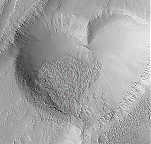
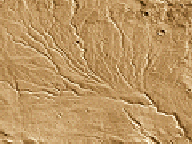
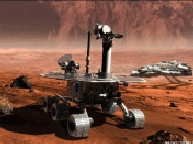
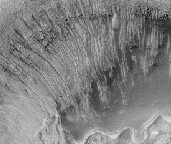
"The human perspective on Mars has flickered over the centuries, but in some sense it has always centered on water. Percival Lowell's famous notebooks -- drawn from telescope observations enhanced by a hopeful imagination -- proposed in the late 1800s that vast, engineered canals, or irrigation ditches, carried water from the Martian poles to a mighty civilization concentrated nearer the equator, where the Martian climate was no less comfortable than, say, "the South of England."A more skeptical assessment by Alfred Russel Wallace in 1907 described a much colder, perpetually frozen place as dead and forbidding as Earth's moon. Still, life-giving waters flowed compellingly through the Mars novels of Edgar Rice Burroughs, while H. G. Wells conjured a race of intellects vast and cool and unsympathetic.
Our first space-age close-up -- a glimpse from Mariner 4 as it swept over a slice of ancient cratered terrain -- revealed a staggeringly inhospitable world."
National Geographic ~ February 2001 Astronomer Johannes Kepler describes elliptical orbit of Mars
MARS REVEALED
Map Insert Feature: A New Look At Forces That Shape The Desert PlanetTIMELINE 1605-2005
Christiaan Huygens's sketch of Syrtis Major records the first recognizable feature on Mars.
William Herschel observes seasonal change at the poles.
Giovanni Virginio Schiaparelli detects a network of canali, or channel-like lines.
Percival Lowell Uses his map of the "canal" system as proof of irrigation ditches on Mars.
Tarzan creator Edgar Rice Burroughs publishes a series of books set on Mars.
W.W. Coblentz calculates that in some places Mars experiences above-freezing temperatures.
Orson Welles's radio broadcast of War of the Worlds panics listeners, who fear a Martian invasion.
Carbon dioxide identified by Gerard Peter Kuiper as component in Mars's atmosphere.
Ray Bradbury's Martian Chronicles describes the first attempt of Earthlings to conquer and colonize Mars.
Cold War Hollywood turns Martians into scary monsters and femmes fatales.
Soviet Union's first Mars effort ends with failed launches of two spacecraft.
Sputniks 29 and 30 fail in attempted Mars flybys. Sputnik 31, a lander, also fails.
My Favorite Martian introduces to television a sweet, non threatening alien.
Mariner 4 achieves successful flyby, transmits first detailed images of surface
Mariners 6 and 7 make close passes at 2,200 miles. Cameras photograph 20 percent of Martian surface.
The Soviets' Mars 3 lands on surface and sends a few brief signals.
Mariner 9 returns 7,300 images, covering entire planet.
Mars 4, 5, and 6 reach Mars, but one crashes, one fails to achieve orbit, and one -- Mars -- transmits images for only nine days.
Vikings 1 and 2 send back data from orbit and the surface. Viking 1 lander makes the first color pictures on Mars.
Phobos 2 photographs the larger of Mars's two moons, Phobos, but vanishes shortly afterward.
Mars Observer, the first U.S. Mars mission in 17 years, loses contact before reaching orbit.
Mars Pathfinder, after a successful landing, dispatches rover to study rocks.
Circling Mars 12 times a day, Mars Global Surveyor collects data for a planetary map.
Japan's Nozomi Orbiter will study Mars's atmosphere.
Mars Climate Orbiter burns up in Mars's atmosphere after a navigational error.
Mars Polar Lander and Deep Space 2 probes fall silent, likely crashing on the surface.
2001 Mars Odyssey orbiter will analyze the makeup of the Martian surface for three years.
The U.S. plans to send two long-range rovers to explore the surface.
The European Space Agency expects to launch its Mars Express orbiter and Beagle 2 lander in 2003.
Future U.S. missions hope to collect rock samples and return them to Earth.

